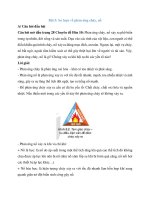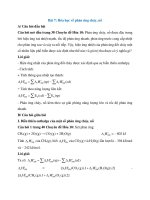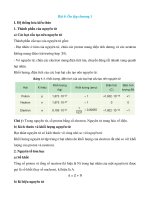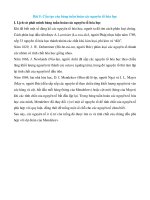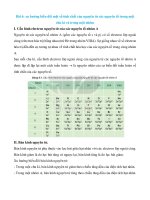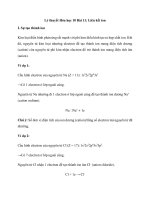Thu âm kĩ thuật số - Hướng dẫn thực tiễn (Tiếng Anh)
Bạn đang xem bản rút gọn của tài liệu. Xem và tải ngay bản đầy đủ của tài liệu tại đây (7.02 MB, 284 trang )
The Art of Digital Audio Recording
The Art of Digital
Audio Recording
A Practical Guide for Home
and Studio
Steve Savage
With photos by Robert Johnson
and diagrams by Iain Fergusson
3
3
Oxford University Press, Inc., publishes works that further
Oxford University’s objective of excellence
in research, scholarship, and education.
Oxford New York
Auckland Cape Town Dar es Salaam Hong Kong Karachi
Kuala Lumpur Madrid Melbourne Mexico City Nairobi
New Delhi Shanghai Taipei Toronto
With offices in
Argentina Austria Brazil Chile Czech Republic France Greece
Guatemala Hungary Italy Japan Poland Portugal Singapore
South Korea Switzerland Thailand Turkey Ukraine Vietnam
Copyright © 2011 by Steve Savage
Published by Oxford University Press, Inc.
198 Madison Avenue, New York, New York 10016
www.oup.com
Oxford is a registered trademark of Oxford University Press.
All rights reserved. No part of this publication may be reproduced,
stored in a retrieval system, or transmitted, in any form or by any means,
electronic, mechanical, photocopying, recording, or otherwise,
without the prior permission of Oxford University Press.
Library of Congress Cataloging-in-Publication Data
Savage, Steve.
The art of digital audio recording: a practical guide for home and studio /
Steve Savage; with photos by Robert Johnson and diagrams by Iain Fergusson.
p. cm.
Includes bibliographical references and index.
ISBN 978-0-19-539409-2; 978-0-19-539410-8 (pbk.)
1. Sound studios. 2. Sound—Recording and reproducing—Digital techniques. I. Title.
TK7881.4.S38 2010
621.389'3—dc22
2010032535
9 8 7 6 5 4 3 2 1
Printed in the United States of America
on acid-free paper
For my daughters Sophia and Thalia.
Thanks for all the hours of training!
This page intentionally left blank
Acknowledgments
vii
This book was written because Norm Hirschy at Oxford University Press read
something else that I had written. He asked me if I was interested in writing a
practical guide to recording, and I was very interested. I had been a professional
recording engineer for twenty years, and I had been teaching recording for ten
years, so I felt ready to tackle a book of this nature. Norm initiated the project
and has nurtured it through each stage—thank you! My first mentor was Brian
Risner, who mixed a record I had produced with the artist Bonnie Hayes. Brian
had worked extensively with the band Weather Report, and over the course
of several projects with him I began to learn how creative the art of recording
could be. Brian’s ability to create a very productive and positive environment
in the studio—while effortlessly handling all the technical requirements—has
been a model for all of my work. My good fortune to be teaching in the outstanding Recording Arts program at Los Medanos College has provided the
proving ground for much of what is contained here, and it was the site used for
much of the photography.
I was delighted to discover Iain Fergusson’s diagrams on Wikipedia, and I
was able to track him down in New Zealand and engage him to do the diagrams
for this book. His work exceeded my expectations and is a model of clarity.
The diagrams add enormously to the sometimes laborious descriptions of many
recording functions. My only regret is that we have yet to meet in person (the
joys and vagaries of the Internet)! Robert Johnson is one of the most outstanding students to have come through my recording classes, and just happened to
be a very accomplished photographer as well. His photographs capture details
of the recording process that can only be suggested in words. I was fortunate to
have a long-term working relationship with Fantasy Studios in Berkeley, California, and was able to access their spectacular studios and mic closet for additional photos included here. I was aided in creating many of the screenshots
by long-time musical collaborators Curtis Ohlson and Paul Robinson. Curtis
runs Digital Performer in his home studio, as well as being a gifted bass player
and producer. Paul Robinson is a Logic user, as well as a wonderfully versatile
and talented guitar player.
I am indebted to a long list of artists and producers whom I have worked
with over the years for all of the wonderful hours we have spent together in the
studio. I have attempted to condense something of the breadth of those experiences and the joy of making records into these pages.
This page intentionally left blank
Contents
ix
Introduction • xi
1 The Starting Point: Sound Meets the Computer • 3
1.1 Why Computers • 3
1.2 What Does It Sound Like? • 6
1.3 Signal Path • 7
2 The Essentials: Where and How Recordings Are Made • 10
2.1 Recording Rooms and Control Rooms • 10
2.2 Studio Monitors • 14
2.3 Microphones and Mic Placement • 18
2.4 Mixing Boards and Control Surfaces • 29
2.5 EQ: General Information • 44
2.6 Dynamics (Compressors and Noise Gates) • 55
2.7 FX: Delays • 67
2.8 FX: Reverb • 69
2.9 Beyond Traditional DSP • 71
3 Recording Sessions: A Practical Guide • 76
3.1 Setup • 76
3.2 Headphone Mixes • 89
3.3 Survey of Recording Techniques for Instruments and Voice • 93
3.4 Beyond • 117
4 Editing: The New Frontier • 119
4.1 Editing Features • 119
4.2 Screen “Real Estate” • 130
4.3 Virtual Tracks (Playlists) • 132
4.4 Advanced Editing • 138
5 Three Fundamentals: Techniques Every Recordist Needs
to Know • 154
5.1 Inserts/Plug-ins • 154
5.2 Send and Return • 159
5.3 Auto-switching (Auto-input) • 165
6 Mixing: The Most Creative and the Most Challenging Stage • 170
6.1 Mixing Requirements • 171
6.2 Building a Mix • 176
THE ART OF DIGITAL AUDIO RECORDING
6.3 Automation and Recall • 199
6.4 Mix Collaboration, Communication, and Delivery • 205
x
7 Mastering: One Last Session • 210
7.1 What, Why, How, and Where • 210
8 Three Best Practices: Easy Ways to Raise the Level of
Your Sessions • 222
8.1 Session Flow • 222
8.2 Talkback • 228
8.3 Playback Volume • 234
Addendum 1 How to Walk into a Commercial Studio and Be the
Engineer • 239
Addendum 2 Researching and Buying Gear: Internet vs. Brick and
Mortar • 242
Appendix
Digital Audio Formats, Delivery, and Storage • 246
Online Glossary Link • 254
Index • 255
Introduction
xi
About This Book
Making great recordings requires striking the right balance between technical know-how and a practical understanding of recording sessions. Even in the
digital age, some of the most important aspects of creating and recording music
are completely nontechnical and, as a result, are often ignored by traditional
recording manuals. Getting the best audio recording results often requires as
much common sense and attention to the recording environment as it does a
deep understanding of the technical elements involved. Too many books about
recording provide technical information but don’t supply the practical context
for how and when to apply the tools and techniques described. This can leave the
reader without a sense of priority, trying to figure out what is actually important
to the recording process in specific situations. The Art of Digital Audio Recording can teach readers what they really need to know to make great-sounding
recordings with their computers—the essential practical, as well as technical,
information, including:
•
•
•
•
•
•
•
•
•
What to look and listen for in your recording environment
Straightforward advice on recording almost any instrument
The essentials of digital audio workstations (DAWs)
The essentials regarding recording gear: microphones, mixers,
and speakers
The fundamentals of understanding and applying EQ, compression, delay, and reverb
The secrets to running creative recording sessions
The practical application of digital editing, mixing, and mastering
A special section that identifies the most common challenges of
the recording studio.
Addendum:
• How to walk into a commercial studio and be the engineer
• Researching and buying gear: Internet vs. brick and mortar.
• Appendix
• Digital formats, delivery, and storage
The Art of Digital Audio Recording is a reference manual for the home
recordist, a textbook for any basic to intermediate DAW training class, and a
primer for the musician who is either doing his or her own recordings or simply
wishes to be better informed when working in the studio.
THE ART OF DIGITAL AUDIO RECORDING
About the Author
xii
My personal path into recording and audio production, and from there to this
book, began with a career as a drummer. I played in numerous unsuccessful
rock bands, learned some jazz without ever coming close to mastering it, studied and performed African music with a master drummer from Ghana, and
spent a couple of years actually making a living as a musician, playing in a dance
band. After a short but glorious stint in a punk band, my career transitioned
into recording and production.
I discovered that the other side of the glass—the control room rather than
the recording room—fit me better, and my career slowly built up around recording. I had a 12-track studio in my garage (equipped with the short-lived
Akai recording format) and recorded demos for rock bands for dirt-cheap. One
of those bands put its resources together to go into a professional studio to
record a single and asked me to be the engineer/producer. There, I got my first
taste of making commercial recordings and I was hooked. I recorded a variety
of fledgling “new wave” artists’ singles and albums in the heady early 1980s, and
I cut my teeth on 24-track analog recording. After a stint as house producer for
a small indie label—where I built and learned to operate a lovely little state-ofthe-art SSL studio (Solid State Logic makes some of the best and most expensive consoles and control surfaces)—I became a full-time independent record
producer and engineer.
One tends to get work in areas where one has some successes, so it was
through my work with the very talented songwriter Bonnie Hayes that I have
ended up working on many singer/songwriter music projects, and after three
Grammy-nominated CDs with the master blues artist Robert Cray, I have
had the pleasure of working on many blues records. I have also recorded jazz,
R&B, rap, hip-hop, country, opera, music for musicals, and children’s records. I
have been the engineer and/or producer on over 100 commercial releases and
have served as the primary recording engineer and mixer on seven Grammynominated CDs, including records for Robert Cray, John Hammond Jr., Elvin
Bishop, and The Gospel Hummingbirds. I have also taught recording in the Recording Arts Department at Los Medanos College in Pittsburg, California, one
night a week for the past ten years. This book is a result of those experiences,
both in the studio and in the classroom, along with the countless hours reading various books, trade magazines, and (increasingly) Web sites that provide
an endless supply of information and opinion about the world of recording.
Through it all, it is my love of music that makes me love my work. I am deeply
grateful for the opportunity to have participated in the making of recordings
with so many talented artists.
www.stevesavage.net
The Art of Digital Audio Recording
This page intentionally left blank
Chapter
1
The Starting Point
Sound Meets the Computer
1.1 Why Computers
The title of this book is The Art of Digital Audio Recording, but it will be apparent to even the most casual reader that the book covers a wide variety of topics
that extend beyond the specifics of computer-based, digital recording. Nonetheless, the title indicates this book’s orientation and that all of the information here is presented primarily in the context of the digital audio workstation
(DAW). Even the most basic recording practices have been influenced by the
migration from analog to digital recording, and this book maintains its focus on
computer-based audio production throughout.
While I don’t think I need to convince you that audio production is dominated by computer-based systems, analog gear remains an important part of the
recording process. After all, sound itself is an analog phenomenon—created by
disturbances in the air—and certain elements such as microphones and speakers remain essentially analog. With other primary recording technologies, such
as EQ, the debate regarding preferences for analog versus digital gear is not
over (and probably never will be), despite the fact that digital dominates almost
every recording environment today. But wherever you stand on the aesthetics of analog versus digital, it is valuable to examine why DAWs represent the
standard in contemporary audio production. By detailing the primary advantages of DAW recording over its analog predecessors, I set the context for the
remainder of this book.
A brief survey of the primary audio practices includes recording, editing, signal processing, mixing, and mastering. In each of these areas, the DAW
3
THE ART OF DIGITAL AUDIO RECORDING
has introduced revolutionary capabilities. The most fundamental change from
analog production has come in the nondestructive capabilities of DAW recording and editing, but signal processing, mixing, and mastering have also seen
dramatic changes in the digital world.
4
Recording
DAWs generally record to hard drives, which allow data to be stored in any
available area of the medium. There is no “erase” head on a DAW recorder—
which is to say that it is no longer necessary to erase (or destroy) previous recordings when making new recordings. As long as there is drive space available,
further recordings can be made. With the enormous capacity and relative low
cost of current hard drives, this effectively means that no recordings need ever
be eliminated.
Along with doing away with the need to ever erase anything, nondestructive recording has transformed the recording process by allowing for many
more recorded elements to be available in any given project. As you will see in
more detail in chapter 4, when I explore virtual tracks, nondestructive recording changes the way people work with audio in more ways than just eliminating
the problem of running out of analog-tape tracks. Whole new working procedures have evolved within the nondestructive environment of the DAW.
One such example is the way that nondestructive audio has transformed
one of the most basic production practices: punching-in. Punching-in typically
involves the rerecording of parts of previously recorded elements. A common
example is replacing a line from an already recorded vocal performance. On
an analog tape recorder, punching-in required erasing what was previously recorded. This sometimes led to difficult decisions about whether it was worth
losing the previous performance in the hope of getting something better. Analog punching-in also involved the potential risk of accidentally losing parts of
the recording, because the beginning or ending of material around the part
to be replaced might get clipped off if the punch-in was not done accurately
enough. With nondestructive recording, these problems have been eliminated.
Parts of recordings may be replaced without losing (erasing) the part that has
been replaced; you never actually have to “record over” any element, as each
element remains stored and accessible from the hard drive. Also, accidental
“punches” (recordings) don’t eliminate previously recorded material for the
same reason—the process is nondestructive so nothing is actually lost. Nondestructive recording has eliminated many of the most basic limitations of the analog
recording process.
Editing
In regard to editing, new capabilities in the DAW are even more significant than
the changes DAW brought to recording. The nondestructive quality of DAW-
The Starting Point
based editing provides vast new opportunities for audio manipulation. With
nondestructive DAW editing, you simply create alternative instructions as to
how to play back the audio that has been recorded. Because the manipulation
of audio in a DAW is separate from the storage of that audio on the hard drive,
you can edit without altering the original recording. This is a major improvement over tape-based editing, which required the physical cutting and splicing
of tape. Not only do you no longer endanger the storage medium by cutting
tape, you are able to edit much faster and in many more flexible ways than ever
possible with tape splicing. Whole new recording and working procedures are
now built around these editing capabilities. I explore this new world of editing
capabilities in much greater detail in chapter 4.
Signal processing
Signal processing has also been transformed by the DAW, though that has been
a slower process of change than with recording or editing. Digital EQ, dynamics
processing (compression, etc.), and ambient effects (reverbs, delays, etc.) operate in much the same way as they did in the analog world. While it has taken a
considerable amount of time and development to produce digital equivalents
of these signal processors that compare in quality to their analog relatives, they
have finally arrived, though whether they are truly a match for the best of the
analog versions is a still very much debated. These processors were already used
nondestructively in analog production—applied to already recorded signals
and easily altered or removed at any time. The big changes in signal processing
have come with wholly new capabilities that were not at all available in analog.
These include the ability to speed up or slow down audio without changing
pitch and the ability to analyze and alter the subtleties of pitch with tools such as
Auto-Tune. There are also an increasing number of processing tools that operate based on a detailed analysis of audio content that is available only through
computerized technology. I look more thoroughly at some of these developments at the end of chapter 2, when the discussion goes “beyond” the familiar
kinds of signal processing.
Mixing
The DAW has advanced the kinds of control over the mixing stage—controls
that were begun when automation and recall began to be implemented in analog consoles. Automation allows for the “automatic” replaying of changes in
volume and other typical mixing moves, while recall enables the recordist to
regain all of the mix settings at a later time—in order to revise mixes. Suffice it
to say that even the early implementation of automation and recall in the analog
realm required the interfacing of a computer to control these functions. Now
that the entire mixing process may be computer based, the implementation of
automation and recall have become much more elaborate and also more reliable.
5
THE ART OF DIGITAL AUDIO RECORDING
The DAW has also vastly improved the ability to automate mixing moves offline, using a graphic interface that provides extremely fine control over desired
changes. These features and the evolution of mixing in the DAW are covered
thoroughly in chapter 6.
6
Mastering
The final stage of production—mastering—prepares the final mixes for manufacturing. The combination of digital delivery (from CDs to mp3s and beyond)
and DAW production has meant that just about anyone can create a master that
is usable for CD manufacturing or online delivery. The large lathes required
to create vinyl LP masters are still used for that format, but that has become
a very small part of the audio marketplace. New tools for mastering to digital
formats such as CDs have resulted in what many believe to be both a blessing
and a curse—a blessing for the technologies that allow CDs to sound better
than ever, and a curse for the ability to overuse some of these technologies at
some significant cost to the original musical dynamics. All of these techniques
and controversies are covered in chapter 7. It is noteworthy that books such as
this one now cover the practical application of mastering techniques for a broad
audience, as these technologies have only recently become available outside of
what was once a very specialized (and expensive) mastering facility.
Digital versus analog
The overwhelming advantages of DAW production have resulted in the predominance of computer-based audio production in both amateur and professional music recording. Still, this leaves the question: Does digital sound better
or worse than analog? The wide range of opinions you find in a typical audio
discussion group suggests that there is no one answer to this question, though
I would maintain the following: (1) There are so many factors in creating goodsounding audio (and even in defining what is meant by “good-sounding”) that
the analog/digital divide is a relatively small element in the overall mix of factors pertaining to quality; and (2) like it or not, we live in a digital audio world
and most of us will spend most of our time recording, editing, processing, mixing, and mastering audio in a DAW!
1.2 What Does It Sound Like?
While many things in the digital domain are held over from the analog era, at
the same time much has been changed by the DAW environment. For all the
changes, one thing—the most important thing—remains the same. This is the
guiding principle in audio production: What does it sound like? These are the
words spoken by Ray Charles in the extraordinary documentary Tom Dowd &
the Language of Music, which traces Dowd’s remarkable career in audio produc-
The Starting Point
tion. Ray is summarizing his point of view about recording and expressing his
affection for Tom Dowd, who shared his passion for sound. Ray reminds us to
keep the focus where it belongs, on the sound, instead of on preconceived or
technically drilled notions of what “proper” technique is. After all, it is only the
sound of the recording that the listener hears.
So throughout this book, while the bulk of the time is spent on the technicalities of recording, I have tried not to lose sight of this much more subjective and much more important element in audio production: creative listening.
There’s a saying in jazz that in order to play “outside,” you must first learn to
play “inside.” This means that the important business of pressing the boundaries and breaking the rules works best when the boundaries and rules are well
understood. As with playing music, the art of recording music requires that
rules be broken, as well as followed; and as with music, the better the rules are
understood, the more effective will be the bending and breaking of those rules.
So dive into the technique and the theory, but don’t forget to come up for some
creative breaths of fresh air!
1.3 Signal Path
Technically speaking, the entire job of a recording engineer is summed up in
these two words: signal path. The engineers are responsible for what is happening to audio from the beginning to the end—from the creation of the sound
waves by the musician playing his or her instrument to the recreation of the
sound waves by the speakers in the listener’s living room. You might pick up
and/or leave the audio chain at intermediate points—perhaps starting as samples used in drum loops and ending when you turn the project over to a mixing
or mastering engineer—but in any event, when you work on sound you work
within the context of a signal path.
One of the first challenges of signal path is simply getting the sound from
one place to the next. Getting the sound from the microphone to the recorder
and from the recorder to the playback system can be a challenge in itself. Add a
lot of processing gear, such as compressors and EQs, and monitoring demands,
such as headphone mixes for musicians, and setting up the correct signal path
can be complicated. I can’t cover all the contingencies here, but there is much
more said about signal path in almost every section of this book. Here, at the
beginning, I lay out some basics.
Input and output (I/O)
To start with, signal path is controlled by the most essential technical element
in audio production: input and output (often shortened to I/O). Following the
audio’s signal path (also referred to as signal flow) is the same as following a series of inputs and outputs, and it is often referred to with another essential audio
term, routing. I/O routing can be pretty straightforward in some cases. For ex-
7
THE ART OF DIGITAL AUDIO RECORDING
8
DIAGRAM 1.1
A simple signal path: DAW
mic input to speakers
ample, in a system where the DAW interface has a microphone preamp built
in, the signal path may be as simple as: sound source inputs to microphone,
microphone outputs to the mic input of the DAW audio interface, the interface
outputs to the computer software that then handles the signal path until it is
output back to the interface, and from there output to the playback system. In
this example, assuming the DAW interface is already set up, the only external
connection the engineer might have to make is connecting the mic to the mic
cable and the other end of the mic cable to the audio interface.
On the other hand, the signal path’s I/O routing may be very complicated,
involving multiple inserts, patch bays, talkback systems, cue systems, and so
on; and each of these may be either hardware of software based (or both)! All
of these topics are considered later in this book, with the focus on the software/DAW side, but it is not possible for any book to cover all possible routing
schemes. What’s more, the internal routing systems within each brand of DAW
may differ in both terminology and implementation. You will have to learn the
I/O intricacies for your own setup, but it is most helpful to begin with this basic
understanding: every thing you do starts with signal path, and signal path is defined by the input and output routing series.
The I/O model of signal path is also in operation on a micro scale within
each dedicated audio element, from stomp box to DAW. You may have seen
schematics for individual pieces of gear or computers; they are complex grids
of inputs and outputs. Audio engineers do not necessarily need to be familiar
with the internal workings of audio or computer hardware, though sometimes
that knowledge can be helpful. In any event, a strong understanding of signal
flow between gear and within software is essential for making good recordings.
Troubleshooting
Troubleshooting—an unfortunate but inevitable part of every engineer’s
job—also starts with signal path. The best way to troubleshoot most technical
problems is to investigate each step of the signal path, starting with the sound
The Starting Point
source, in order to determine where the problem lies. Whether it’s poor-sounding audio, noisy audio, or simply no audio at all, the problem lies somewhere
along the signal path. A systematic approach that examines the I/Os from the
beginning of the chain is the best and most efficient approach to solving almost
all technical problems.
Combining the technical and the aesthetic
Recording always entails finding the proper balance between creative and technical demands. Considering the question “What does it sound like?” takes you
to the essence of the creative process—ultimately, that is all that matters. Understanding the basis of signal path takes you to the essence of the technical
process; these are the nuts and bolts that must serve the aesthetic. With this
grounding in both the aesthetic and the technical, you are ready to tackle some
much more specific elements in audio production, beginning with the essentials of where and how recordings are made.
9
Chapter
2
10
The Essentials
Where and How
Recordings Are Made
2.1 Recording Rooms and Control Rooms
This opening section is going to be relatively brief—there are many other resources for delving more deeply into the technicalities of acoustics. For most
of us, the idea of constructing a space for recording is not part of our work. We
recordists are either stuck with certain spaces because we need to work there
or perhaps we live there, or we choose to work at studio spaces based on experience or reputation. Nonetheless, there are some fundamentals about sound
and space that every recordist should be familiar with, and some helpful ways
of dealing with basic problems. I summarize the issues concerning the physical space that we work in, dividing them into three basic topics: isolation, frequency response, and ambient characteristics.
Isolation
In regard to isolation, there are two main considerations and one basic rule. The
things to consider are isolation from outside noise leaking in, and isolation of
inside noise leaking out. Either or both may be problematic, but the solution
for both—the one basic rule—is the same. That rule is that isolation is created
by a combination of mass and density. That is to say, the way sound leakage (in
either direction) is prevented is with sufficient mass that is sufficiently dense.
What this means in practical terms is that a 12-inch-thick wall of dense concrete will isolate sound much better than a typical wall with two sides of sheetrock and an air cavity in between. Studios in highly problematic environments
have been known to resort to sheets of lead as part of the wall structure. This
The Essentials
can work well, but can also be very expensive. If you are fortunate to work in
an environment with little external noise and without sensitive neighbors, you
may have far fewer concerns about isolation. If not, density and mass are your
primary allies.
There is sometimes the notion that more absorption inside a room (from
acoustic panels, to foam, to rugs, to egg cartons) will help solve leakage problems. Unfortunately, this not the case because materials that absorb sound do
so primarily in the higher frequencies and leakage decreases as the frequencies
rise. That is why, if you are standing outside a rehearsal studio with a rock band
playing inside, what you hear is primarily the bass guitar and the kick drum.
It is the low frequencies that permeate walls, mess with recordings, and anger
neighbors, no matter how much dampening material you have inside the room.
Only mass plus density will do an effective job of decreasing low-frequency
transmission.
Isolation does have an effect on the sound in the room, as well. The more
low frequencies are prevented from escaping because they are reflected with sufficient density and mass (such as a concrete wall), the more problems with bass
buildup within the room itself. Solving transmission problems to and from the
outside also engages you in absorption and reflection issues within the room.
There are many other technical elements that will affect transmission, reflection, and absorption; and there are a variety of books that describe common approaches to designing and constructing walls, floors, ceilings, doors,
windows, and HVAC (heating/venting/air-conditioning) systems for recording
studios. These topics are beyond the scope of this book, but very much worth
exploring if you are building or remodeling a space to be used for recording.
Frequency response of a room
The frequency response of a room refers to the way different frequencies, from
low to high, respond to the absorptive and reflective qualities of room surfaces.
Every room has different frequency responses—the room’s physical characteristics cause boosts or dips at certain frequencies—and these are variable to a
certain degree, depending on where you are in the room. Generally, a room
with relatively even frequency response across the spectrum is desirable, and
this can be achieved by controlling the absorption and reflection of sound in
the room. There are some basic principles in this regard, though the details of
designing and controlling room acoustics can get very complex and the results
are never thoroughly predictable.
There are two main enemies of a smooth and even frequency response.
These are right-angle corners and parallel surfaces. Right angles, such as at most
wall-to-wall, floor-to-wall and ceiling-to-wall intersections, will reflect sound
back in the same direction as it has come from and will cause the most prominent frequencies of the original sound to build up, disrupting an even frequency
11
THE ART OF DIGITAL AUDIO RECORDING
12
PHOTO 2.1 and 2.2
Various wall treatments
response. Opposing parallel walls
(or floor and ceiling) create standing
waves by reflecting the sound back
into its own original path. Standing
waves also amplify certain frequencies and disrupt an even frequency
response. Unfortunately, most typical room construction uses a lot of
right angles and parallel surfaces.
Bass frequency buildup and other
unwanted room resonances are an
especially common problem that
may be made worse by right angles and parallel surfaces, but they
are not necessarily eliminated by a
room with neither of those design
characteristics. A whole world of
“bass trap” solutions has evolved,
and there is some debate as to how
effective any or all of these solutions may be. There are companies that specialize in products to aid in improving room acoustics without your having to
tear down walls and rebuild. These are definitely worth exploring unless you
are working in an already well-designed acoustic environment. Most home and
project studios need some acoustic treatment.
Besides creating problems, room reflections can be used to help solve
problems. While many room frequency imbalances caused by reflections may
be solved using absorptive material, too much absorption can make a room
